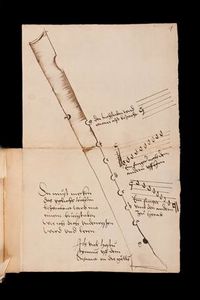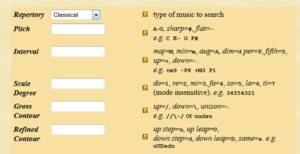Difference between revisions of "Template:DRM portals"
| Line 51: | Line 51: | ||
Website: [http://www.peachnote.com/#!nt=singleNoteAffine&npq=62+0+1+2+0+-2+-1+-2 Peachnote n-Gram Viewer] | Website: [http://www.peachnote.com/#!nt=singleNoteAffine&npq=62+0+1+2+0+-2+-1+-2 Peachnote n-Gram Viewer] | ||
| − | MIDI-based search | + | This MIDI-based search system plumbs a number of score aggregations, such as [http://imslp.org/ ISMLP] to produce a general overview of short melodic phrases. |
===RISM Music Manuscript Inventory=== | ===RISM Music Manuscript Inventory=== | ||
Revision as of 23:04, 25 September 2015
How does one search for musical content that cannot be located by metadata? These websites, each of which employs a different approach, will show you how.
Contents
- 1 Cantus Ultimus
- 2 e-manuscripta
- 3 Europeana: Search Engine for European (Music) Sources
- 4 Gallica
- 5 The Internet Culturale
- 6 Munich Digital Manuscript Collection
- 7 Peachnote Music n-Gram Viewer
- 8 RISM Music Manuscript Inventory
- 9 RISM Switzerland (RISM CH)
- 10 RISM UK)
- 11 Themefinder: Music-Incipit Search
Cantus Ultimus
Website: Cantus Ultimus
This aggregation site at the University of Waterloo (CA) performs melodic searches in several collections of chant data encoded according the the principles of the Cantus database but expanding from antiphoners and breviaries to manuscript sources containing Mass sections and sequences. The databases currently searched are these:
- CANTUS (now maintained by Debra Lacoste, University of Waterloo)
- Portuguese Early Music Database (Manuel Pedro Ferreira, Lisbon)
- Slovakian Early Music Database (Eva Veselovskà, Bratislava)
- Gradualia Project (Gàbor Kiss, Budapest)
- Fontes Cantus Bohemiae (Jan Kolacek and David Eben, Prague)
- Cantus Planus in Polonia (Bartosz Izbicki, Warsaw)
User contributions are welcomed.
e-manuscripta
Website: e-manuscripta

This comprehensive portal for materials in Swiss libraries serves scores, photographs, letters, pedagogical materials, and much else. The five-leaf recorder tutor (from a sixteenth-century manuscript) shown at the side represents its heterogeneity, which also extends to sixteenth-century part-books, organ tablatures, correspondence by Martin Luther, photographs of Ferruccio Busoni, and a thousand maps.
Europeana: Search Engine for European (Music) Sources
Website: Europeana
This umbrella site for European digitization projects covers a great deal besides music. To start, limit the search by an obvious word for music (musique, musica, Musik, etc.). This will give you an idea of how to further limit the search. Europeana is updated often. Among the items that should be visible are music prints, manuscripts, newspapers dedicated to music, sheet-music, audio files, etc. Since Europeana is an aggregation, it provides links back to the sponsoring libraries that hold the original sources. The site can be searched in many languages.
Gallica
Website: Gallica
Gallica provides access to an enormous array of digitized materials from all periods of French history and many aspects of French musical life in addition to great quantities of non-musical material. Among its highlights are illuminated manuscripts contained the poetry (much of it set to music by Guillaume Machaut), manuscripts of the operas Francesco Cavalli composed for the wedding of Louis XIV, a very large amount of music printed in France in the eighteenth and nineteenth centuries, and important documentation for theatrical history.
The Internet Culturale
Website: Internet Culturale
An umbrella site for digitized materials in Italian libraries. The riches of Italy's collective Internet Culturale (cultural internet) are difficult to overstate. A vast span of different kinds of graphically reproduced material will be found here. All of it is accompanied by generous supplies of metadata from cataloguing records. While one may be able to find a specific item such as an opera, one may also discover on a different spoke a list of all the works in which the singer of an aria appeared. Users can create accounts to collect previous discoveries in one place.
Munich Digital Manuscript Collection
Website: Munich Digital Library Manuscripts
The collection of digital materials grows so rapidly that any listing of individual collections within it is doomed to be incomplete. Several projects are cooperative. The historical foundation rests on the Middle Ages and Renaissance, with much emphasis is given to religious figures and documents (e.g. at Europeana Regia). A combined search engine (http://www.digital.collections.de) for all the digitized materials in the Bavarian State Library is currently under development.
Peachnote Music n-Gram Viewer
Website: Peachnote n-Gram Viewer
This MIDI-based search system plumbs a number of score aggregations, such as ISMLP to produce a general overview of short melodic phrases.
RISM Music Manuscript Inventory
Website: RISM Music Manuscript Inventory
This inventory of musical manuscripts in roughly 60 countries was begun in 1952. It is still growing (under the management of the Répertoire International des Sources Musicales). Online implementation is based at the Bavarian State Library. RISM's numerous virtues are easily discovered through in us. A RISM blog keeps registered users informed of current activities. RISM has working groups on most continents. Much material currently contained in RISM books will (with updating) find its way online over the coming years. Those interested in contributing to RISM's efforts may contact a local representative by looking here.
RISM Switzerland (RISM CH)
Website: RISM Switzerland
The RISM Switzerland is the Swiss database of the Repertoire International des Sources Musicales (http://www.rism.info). This database contains additional material that is not listed in the international database (http://opac.rism.info), including sources from the 19th and 20th century.
RISM UK)
Website: RISM UK
The United Kingdom RISM site has a number of special features: cross-linking with Early Music Online; an impressive image gallery, useful for quick comparison of handwriting and paper; a lookup table for places of publication; and useful collection-level clusters of indexing. UK manuscripts were the earliest sources to be catalogued by RISM, and the depth of information reflects almost 50 years of accrual.
Themefinder: Music-Incipit Search
Website: Themefinder

The Themefinder search engine was prototyped at CCARH in 1996 by David Huron, Andreas Kornstädt, and Walter B. Hewlett. A large number of Stanford University students including Unjung Kim and Leigh VanHandel plus visiting students including Bret Aarden participated in its early development. The search engine was originally developed to study user behavior. Over the intervening years it has been used for a large statistical study of search-efficiency. The current search engine was built and is maintained by Craig Stuart Sapp.
Themefinder contains several repertories, most of which are publicly viewable and searchable. The principal repertories are Folk, Classical, and Renaissance. Although more than 100,000 incipits and associated metadata are present in the database, users may select just one. "Hits" satisfying search-criteria can be collected on the Themefinder Clipboard and can be exported.
Incipits can be searched at five points on a continuing from the most specific to the fuzziest. Filter for meter, mode, and key may be used. MIDI files are available for each entry. Help menus are available at the website. Those interested in contributing an encoded repertory to Themefinder should describe the existing repertory and format in a query letter.
Related literature: "Search-Effectiveness Measures for Symbolic Music Queries in Very Large Databases" (Craig Stuart Sapp, Yi-Wen Liu, and Eleanor Selfridge-Field, ISMIR Proceedings 2004)